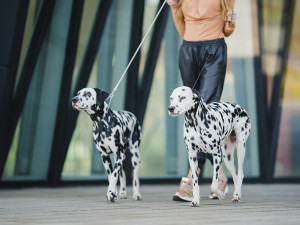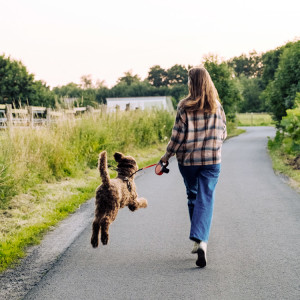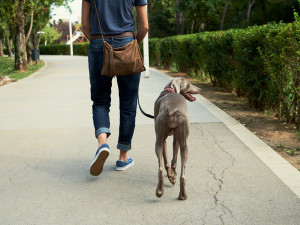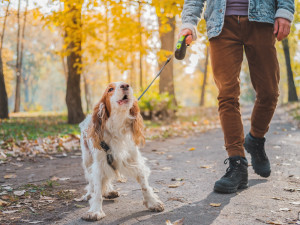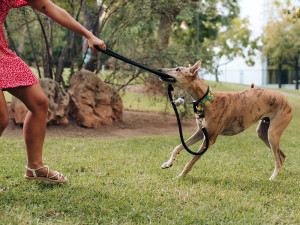Why Keeping Your Dog On The Lead Isn’t ‘Bad Pet Parenting’
Keeping your dog on a lead isn’t mean – sometimes, it’s the kindest choice
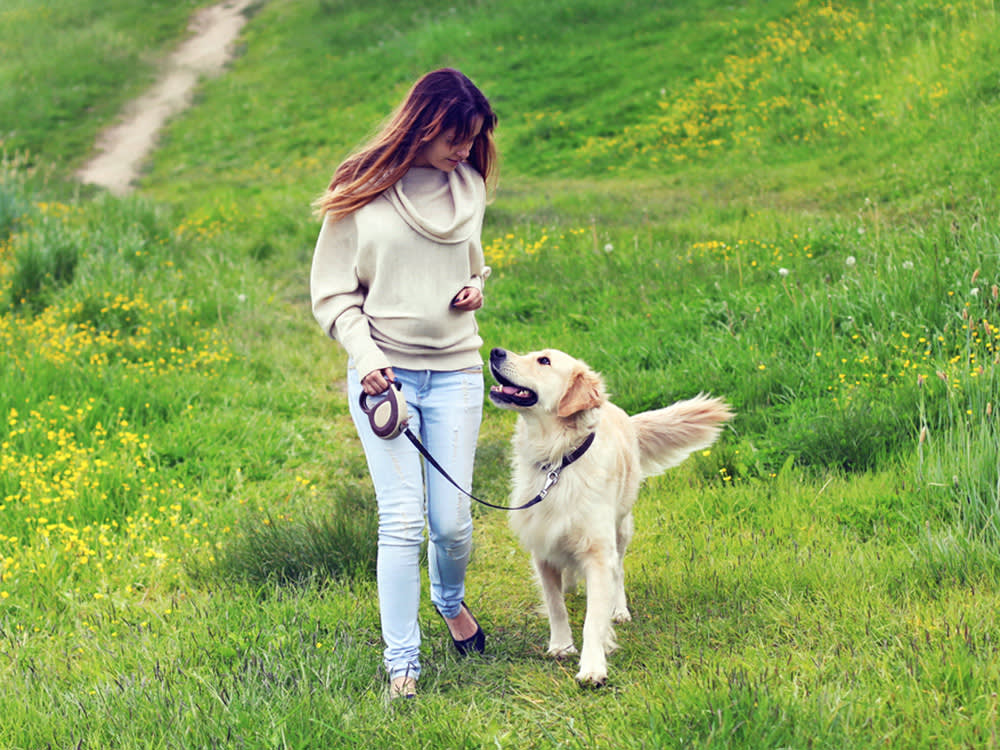
Share Article
Pet parenting can be a lot. There are some topics that are especially divisive – a dog being on a lead is one of them. There’s a prevalent feeling that anyone who keeps their dog on a lead is somehow overprotective/wrong/cruel (delete as appropriate). And before I adopted my rescue dog Lucy, it crossed my mind, too. Dogs need to run free, right? I had a romantic vision of letting Lucy off lead, her running back back to me when I called her name. That’s what it looks like in films. It means they love us, doesn’t it? The purest kind of devotion.
“We often imagine walks with our dogs being free to run and play,” says Dawn Allen, certified canine behaviourist at Four Positive Pawsopens in a new tab. But Dawn believes that’s because it gives us a good feeling to see our dogs ‘enjoying’ themselves off lead. But it shouldn't be about us.

littleKin™ is Kinship’s home just for puppy and kitten parents. Bop over to check out expert advice, new pet tools, and special deals—all curated for your newest family member.
opens in a new tabWhat I’ve come to learn – in the course of my journey with Lucy, and also meeting experts for this feature – is that I was thinking about the lead all wrong, it’s not about restricting our dogs, it can be about being kind to them, and other dogs. Like holding someone’s hand, it’s a way to feel closer to them. Now when I clip on Lucy’s lead, I think about the freedom that gives her. She can relax and get on with all her important sniffing and know that I’ve got her back. Let’s get into it…
Why do so many of us think leads are bad?
“There’s a strong belief that a dog on lead is deprived of natural behaviours,” explains Dawn, which plays into every pet parent’s fear that their dogs aren’t getting enough exercise or mental stimulation. (Oof, I feel that.)
“Social pressure plays a part, too,” says Rima Chehlaoui, a behaviourist at Even Better Dogs K9 Behaviour and Trainingopens in a new tab. There’s always a civilian ‘non-professional’ offering up advice on the dog walk.
I’ve fallen victim to it. Lucy’s been with us for over four years now, but six months in when we were still learning about each other, I got talking to a guy with two rescue dogs in the park. I’d still not let Lucy off lead – but was clinging to the dream that, one day, I would. “Your dog looks more bonded to you than mine are to me,” he said, nonchalantly. “Go on, let her off.”
At first, Lucy stuck by me. “See,” said the man. Then she started running and I was like, “wow, this girl can move”. Next thing I know, she disappeared into a bush. I hold my breath; heart pounding. In my head, I’m calling my husband to tell him I’ve lost our dog – or worse. Then she reappears, covered in mud – it must have been minutes but it felt like tortuous hours. I clipped on her lead and vowed to be more careful.
What does the law say?
“By law, your dog must not be ‘dangerously out of control’ in a public place,” says Rima. “This means injuring someone, or making someone fear they may be injured.” Your dog jumping on to someone – “even in a friendly manner” – can be considered “dangerously” out of control. The Highway Code states that dogs should be kept on a short lead when walking by a road. Plus, local authorities have bylaws that require dogs to be kept on a lead in certain public areas.
Lead walking: unravelling the myths
Dogs aren’t human. Yes, they are sentient beings and they love us in their own way, but sometimes their instincts take over or something might scare them and if they aren’t on a lead, they could end up somewhere they shouldn’t. Even the most highly trained dog could be startled by a loud noise.
Especially ingrained is the belief that a lead is somehow cruel, or yet another reminder that our dogs can never be truly free. “People feel guilty about walking a dog on lead or that they’re being judged,” says Dawn.
And Rima has a rebuttal for the ‘freedom’ argument because freedom, she says, can lead to danger. “Some dogs and puppies can become overwhelmed when they’re given too much freedom,” she explains.
Not all dogs need to be off lead to “expel energy,” she continues, “that’s a ‘one size fits all’ mindset, but our dogs must be treated as individuals. Yes, running can be beneficial, but too much running can cause over-stimulation – which can lead to nipping, biting, humping and jumping up.”
Sometimes it’s not about your dog, it’s about other dogs
“They’re friendly!” are the two most dreaded words you can hear as a reactive rescue dog parent. Kinship editor, Orla Pentelow, and her rescue dog Luna agree. “It drives me up the wall,” says Orla, “but it shouldn't matter whether their dog is friendly, what about the dog they're bounding over to? They could be reactive and it could spark disaster.”
These people have what Rima calls poor ‘lead etiquette’. “If you see a dog on lead nearby, recall your dog and put them on lead as you go past,” she recommends. “It’s about consideration. Especially if you see an on-lead dog being trained or the owner moving out of the way – give them a wide berth.” Remember, says Rima, “just because your dog is friendly, other dogs may not be. Just because your dog is OK with something, another dog may not be. Never assume.”
Veterinary nurse Zoe Blakeopens in a new tab feels this way, too. One day, when she was out walking her dog, a “bouncy golden retriever” came up to them, “the owner nowhere in sight,” she says. “I got my on-lead dog to focus on me and eventually the retriever ran off.” That’s going to end up in trouble, she thought to herself.
Low and behold, as Zoe was coming to the end of her walk, she heard a dog fight. “I rushed over and it was the same retriever and he’d been attacked by an on-lead dog.” Zoe spotted the woman with the reactive dog crying – “her husband had been bitten”.
The incident stayed with Zoe, she kept reliving it. “The noise of the dogfight, the screaming,” she says with a shudder. “All of that happened because someone didn’t realise it’s not a great idea to let their ‘friendly’ dog run free with no recall.”
How many more accidents are waiting to happen? That’s why Zoe set up the Respect the Lead campaignopens in a new tab, which encourages dog parents to think about why other dogs are on a lead. “Maybe they’re recovering from surgery, elderly, not confident around other dogs or simply still learning about the world,” she says. Zoe’s aim is to build a safer community for our dogs to thrive in – after all, we already expect so much from them in our human-centric world.
Zoe started the campaign as a poster that she shared on Facebook, but it resonated – “it went viral,” she says. But sadly, “there’s still a lot of people who don’t get it,” says Zoe. An off-lead dog can derail a reactive rescue dog’s confidence building or a puppy’s training. It’s about respect.
Rima points out that it keeps other animals safe, too. Perhaps your dog has high prey drive – which adds a layer of complexity to training. “It’s an innate and genetically driven behaviour, which all dogs have to a greater or lesser degree,” explains Rima. “The higher the prey drive, the harder recall can be to train because it’s challenging to eliminate this instinct completely.” If your dog can’t resist the urge to chase, then “it’s more humane to keep them on lead – especially for the smaller animals that might be impacted.”
How can we enrich our dog’s life when they’re on the lead?
A good training session or a long walk – “with lots of sniffing, finding treats, playing fetch and even just sitting quietly and taking in the world together – can be just as tiring and stimulating as running,” says Rima. So get creative. Let your dog choose which way to go, as long as it’s safe of course, let them lead you. Dawn advises devising a “menu” of walks to choose from. “Industrial estates and car parks out of hours, graveyards, nature reserves and golf courses are some of our favourites,” she says, each facilitating opportunities to use natural senses to fulfil their needs. Dogs have 300 million scent receptors in their noseopens in a new tab, so a 20-minute walk with lots of stopping and sniffing could even be more stimulating and tiring than an hour-long power walk. Like social media for us, sniffing is how they communicate and soak up information – some have dubbed it “peemail”. Plus, it releases dopamine to calm them.
Walks are so much more than simply exercise for our dogs. “They’re an opportunity for us to be with them,” continues Dawn, who believes the lead is a way to interact, building trust and nurturing our relationship. “When our dogs are on lead they’re connected and we can support them by being present.”
Do this by playing a game together, for example, fulfilling their hunting instincts by creating a ‘treat tree’. “Find a suitable tree and push some cheese or sausage into it and let your dogs explore using their sense of scent,” she says. “Lay a treat trail or create a treasure hunt for them to explore and problem solve.”
For super high-energy dogs, Zoe recommends Canicross (running with dogs), Bikejoring (off-road cycling with dogs) and mantrailingopens in a new tab (scent trails). “It’s a way to increase exercise exertion for active breeds,” she says. Plus, moving together in sync builds your bond further.
The lead can also be reframed as a tool for gradual freedom. “Use a long line, allowing more distance between you and your dog,” recommends Rima. “If at a certain distance communication breaks down, go back to shorter distances, gradually allowing more again.” Always reward your dog when they come back to you.
Never stop teaching
Most importantly, “training is ongoing for your dog’s whole life,” says Zoe. Rima is in agreement and recommends a “let’s work on it” approach – “training depends on how much you put in.” And that’s why I never leave the house with Lucy without a reward in my pocket! It still shocks me how many pet parents don’t do this and wonder why their dog is following me!
Rima believes a lot of dog parenting is about mitigating risk. “It’s our duty to keep not only our dogs and ourselves safe, but also other dogs and people,” she says. “If keeping your dog on lead gives you better odds at that, then I’d pop my dog on a lead.” And who can argue with that?
Lucy’s now mostly an on-lead dog, and I’m OK with that. She runs in her garden and on her long line and occasionally, if I’ve conducted a full risk-assessment, she has some off-lead time in the park. I allow her autonomy by letting her choose her route, and she surprises me sometimes when she pulls me down the sniffiest streets to places she’s never allowed off her lead. I’ve noticed how she visibly relaxes when she’s close to me – she knows she’s safe and what could be more freeing than that?
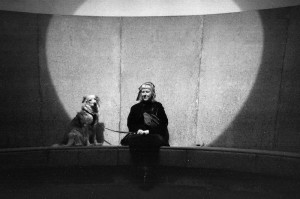
Alice Snape
Alice Snape is a freelance writer and editor whose work has featured in Cosmopolitan, Metro, Red, Vice, amongst other publications. Her rescue dog Lucy is the love of her life – probably because she’s an anxious weirdo like her. You’ll likely find them both curled up in bed – Alice’s favourite place to write from – or out having an adventure together in the park…
Related articles
![dog bouncing on lead in the countryside with girl]() opens in a new tab
opens in a new tabHow to Make On-Lead Dog Walks More Exciting
There are plenty of ways to spice them up
![Barking dog on the leash outdoors. Russian spaniel at a walk misbehaving or being bad tempered]() opens in a new tab
opens in a new tabDoes Your Dog Act Diabolical On a Lead?
Same! Here’s how I got my pup to stop barking and lunging at everything that moves on walks
![Greyhound dog biting and pulling his leash held by a woman in a red dress in the grass]() opens in a new tab
opens in a new tabHow to Stop Your Dog From Biting the Lead
Most dogs love walking, but some love chaos a little bit more
![Pet parent comforting anxious dog by holding their paw]() opens in a new tab
opens in a new tab8 Tips for Helping an Anxious Dog
Easy ways to calm your pup’s nerves
